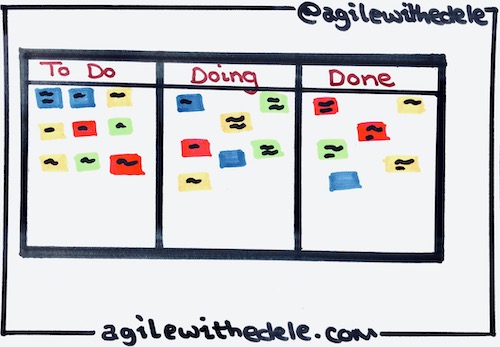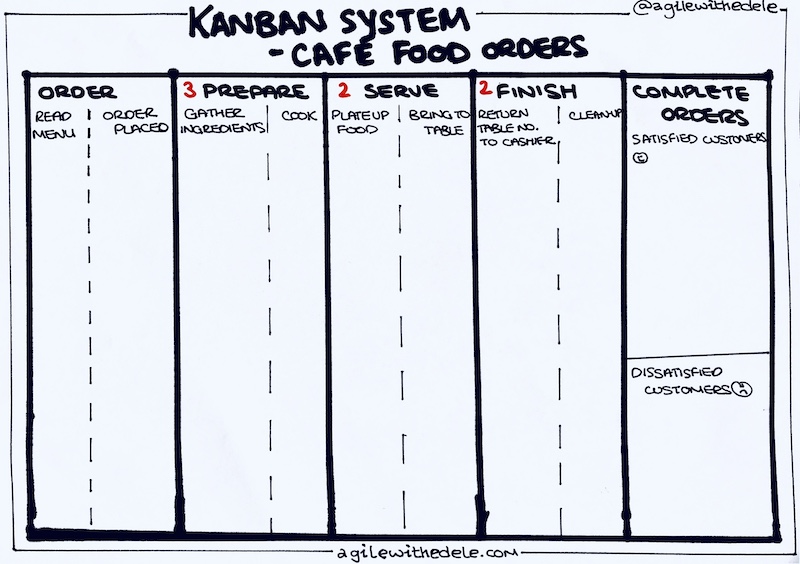This is part 1 of a 3 part blog series to help you start to apply Kanban in your environment. Click here for part 2 or here for part 3.
Most people start using Kanban by creating a board with 3 columns. But a process isn’t just a board - the beginning of the work isn’t when it enters the board, and the end isn’t when the team defines it as being completed. Visualising your work will get you so far, but it’s unlikely to help you understand your customers or what their needs, desires and frustrations are.

In order to get started with Kanban, you need to learn to view your current work as a set of services, rather than products. This helps us discover and define our fitness for purpose - something that’s defined from the customer’s point of view: what’s going to make them choose your business over the competition? The Kanban Method defines a service as:
people collaborating to produce (usually intangible) work products for a customer who requests the work and who accepts or acknowledges delivery of it.
— Anderson, D. J., & Carmichael, A. (2016). Essential Kanban Condensed. Seattle, WA: Lean Kanban University Press.
The service isn’t the product you’re creating, it’s the steps in the process to create that product. Or more specifically, it’s the beginning and the end - someone has to make a request, and that same person needs to accept or acknowledge delivery of it. Most of the time there’s some workflow between those 2 steps.
Even the smallest companies receive requests from different people. You might have different customer types, different businesses you sell to etc, and those different people have different needs. For example, a customer who wants a flat white in a coffee shop has a different workflow to someone who wants a toasted panini. These 2 customers receive a slightly different service, but both contribute to how the customer feels about your café, and the amount of sales you make.
Consider the workflow for ordering a panini:

Visualising the workflow like this can help us identify where the waiting and delays occur so we can brainstorm ways to reduce these. The columns on the diagram above reflect the dominant activity at each stage of the workflow. It’s important to get the level of detail right on your board - being too granular adds overhead for not much value, however we need some level of detail. Simply having “order placed”, “preparing order”, and “order delivered to customer” is a bit too high level, making it difficult to see all the dominant steps of the workflow. The same is true for product and software development - simply having “build feature”, “in development” and “deployed to production” doesn’t give us the context we need to be able to improve the workflow. We want to visualise:
- The value adding steps (time spent actively working on a task in the process)
- The non-value adding steps (time spent waiting between process steps)
- Bottlenecks - for example, is the food ready but waiting for wait staff to bring it to customers for longer than it took for the kitchen staff to prepare the food? What is causing this issue? Do we need extra wait staff or do we need to change how wait staff are alerted that the order is ready to be brought to the customer?
This is the same thing that can happen in software development. For example, I’ve worked in teams where the Quality Assurance step was the bottleneck, which turned out to be caused by only one person in the team performing this activity. The Kanban System allowed us to visualise what was happening and work out a course of action to improve it, which overall improved the flow of value across the board and to the customer.
Coming back to the concept of fitness for purpose, it’s important to recognise that you won’t be able to please everyone all of the time. Do you want to focus on those customers who only buy hot drinks, or those who also make food purchases? For that customer group, ask:
- What will make them come into our café? What will make them purchase rather than browse?
- What will cause them to recommend our café to their friends and family?
- What will make them a regular customer?
For each question also answer the alternative, e.g. what will make them leave without purchasing anything? This could be related to how the food on display looks or based on the type of ambience (music, comfort) that the customer is looking for.
OK, but you’re working in a development team building software, how does this relate to you? Well, even if you’re only building for one business, you’re still creating a product for multiple people. Sure, those people might work in the same department, but they have different needs. Someone who wants to publish news articles online has different needs from their colleague who analyses how much traffic each news article receives. What’s going to make each of those people feel more or less frustrated when they use the website you’ve built? If you don’t know, ask your customers for real feedback - and don’t just rely on bias by asking your favourite customer, make sure to ask a good representation of your target market to find out their sources of dissatisfaction.
Be sure to check out my next blog post for the next steps you need when getting started with Kanban.